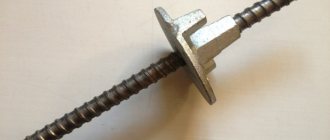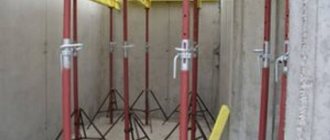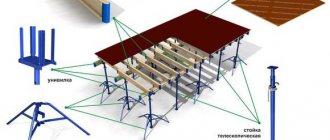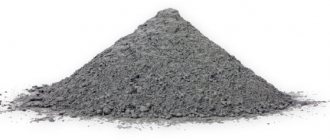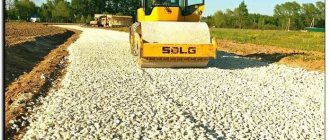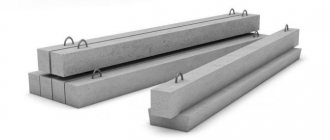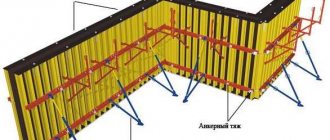In modern construction, monolithic technologies are often used. The peculiarity of this method is that the structures are cast from concrete mortar, and are not assembled from blocks or bricks.
To pour the concrete solution, special forms are assembled from panels. To connect them, rods are used, which are inserted into the mounting holes on the boards. To fasten these stubbles, a special formwork clamp is used; its main purpose is to securely fix the elements.
Reasons for popularity
Spring clamp and installation key
This method of fastening is popular in construction for a reason. After using the formwork reinforcement clamps , no traces remain. This is far from the only advantage. The entire work process will take much less time, physical effort and, most importantly, funds that can be used for other purposes.
Another advantage of using a spring lock for formwork is saving you money. You save not only your money, but also time and physical effort. To use a spring lock for formwork, you do not need any additional equipment other than a key. To use the castle, no additional buildings are required either. The process of using it is very simple.
Clamp Installation
You won't need any pinch screws at all for this process. To use clips, you will need a special key, which is used to tighten the clip after putting it on a special wire, maximum diameter is 10 mm. Formwork clips are widely used. They are used in the construction of premises of any type. Convenient packaging has been thought out for customers, which is packed in boxes and then into pallets.
To install the clamps, which are a kind of lock, it is necessary to extend the reinforcement behind the formwork to a length of about 15 cm.
A spring lock for formwork is the best option, thanks to its design you can:
- save your money during construction;
- formwork clamp is a universal tool that is suitable even for use with non-standard sizes;
- using formwork clamps, you will use much less physical effort;
- in addition, you will do the job faster and better than using clamping screws and nuts.
Spring lock for rebar formwork
The quality of monolithic construction largely depends on the formwork. That is why high demands are placed on each of its elements. A spring lock for formwork under reinforcement must have high wear resistance and reliability. It provides hermetic fastening of shields in both planes, increases the efficiency of wall construction due to the high quality of the teeth of the steel tongue. The spring lock is made by spot welding and stamping. Protected from corrosion. The cost of a spring lock is low. It can withstand a load of 2 thousand kilograms and is therefore used in conjunction with fittings. Today there are stronger and more durable lock models. The use of such a lock does not require the creation of additional holes, which increases the speed of formwork installation.
Characteristics of spring clamp for formwork
Spring clamps are characterized by ease of installation and high performance. The load on a spring clamp can be up to 2 tons or even more, it all depends on the type of clamps. There are regular clamps and reinforced ones. Conventional ones can withstand loads of up to 2 tons, and reinforced ones - more than 2 tons. Some types of reinforced clamps can withstand loads of even 3 tons. The wire diameter ranges from 6 to 10 mm.
Clamps for reinforcement for formwork are one of the new inventions of mankind in the field of construction, which successfully copes with the assigned tasks, and also allows you to complete the work on time, without investing extra money.
The devices that appeared during the development of monolithic construction technology simplified and reduced the cost of previously labor-intensive and costly construction processes. A simple invention - a stand.
Everyone knows that the strongest buildings are built thanks to monolithic construction. It is possible to implement various ideas, as well as obtain designs with any .
Formwork turnover is a measure of the reliability of the formwork system. This property determines the number of operational cycles of pouring concrete during which the formwork retains.
Modern construction cannot be imagined without the use of formwork systems. With their help, walls, columns, ceilings and even tunnels are erected. Most.
What is a formwork spring clamp?
To reduce the time and cost of installing formwork, today a special device has appeared on the construction market that can fix temporary structures quickly and economically - a formwork clamp. Since the disadvantage of wood panels is their deformation, the ability to swell and shrink, the use of mechanical locks will allow you to fix and maintain the distance between the support plates while pouring concrete.
In monolithic construction, a spring clamp for formwork (clip, “frog” or lock) is mainly used.
Scope of application
Ideal pouring parameters when installing large formwork systems provide for reliable fastening of each monolithic element. In such cases, a spring clamp is used, since it simplifies and speeds up the installation of the fence, making it more stable. “Frogs” eliminate the need for spacer tubes while maintaining the tightness of the panels.
Depending on the steel material, the formwork clip can withstand stress of up to 4.5 tons, but the maximum load should not exceed 2.5 tons. The devices are used for collapsible sheet metal and monolithic building systems. The most effective clamp for small-panel formwork is used for medium-thick concrete masses.
Features and Benefits
“Frogs” are a clip installed on a platform with a special tongue that snaps the fittings into place. The formwork spring clamp is produced in Turkey (Prom, Aldem, Hold), Russia (Chiroz company), China, Germany, Poland.
The spring lock differs in the following categories:
- Strength.
- Material.
- Size.
Manufacturing strength affects the ability of spring clips to resist destruction under the influence of external loads. In terms of stability, locks can be reinforced (tensor) or light (ordinary). Structurally, they are no different from each other. However, for different pouring conditions it is necessary to use appropriate subtypes.
Lightweight “frogs” are used for loads of up to 2 tons and have a galvanized toothed tongue; they are manufactured by Prom. Reinforced clips are designed for 2-4 tons, have a nitro-carburized toothed tongue and contain a stiffener that enhances the reliability and stability of the structure. Companies Chiroz, Hold, Aldem produce clamps that can withstand more than 3 tons.
Mechanical clamps are made from low carbon steel. The surface can be galvanized, painted, powder coated or electrostatically sprayed. The Prom spring clamp is made with a galvanized toothed tongue, which avoids its deformation during operation, and Chiroz clips have a hardened ratchet locking mechanism.
The sizes do not differ significantly from each other. The values range from 70 (75) to 105 (110) mm, thickness is 3-4 mm.
The main advantage is:
- installation speed;
- convenience during practical use;
- an alternative to traditional expensive spacers;
- affordable price in contrast to coupling screws and nuts.
DIY installation
The cost of a screed kit depends on the initial components. A regular set includes a spring clip of 50 pieces, a key and galvanized terminals.
Installing or dismantling the devices is very simple. To do this you need to have:
- fittings of a certain diameter;
- clips;
- spring clamp key.
The number of “frogs” will depend on the length of the formwork. The calculation takes into account the intervals through which it is necessary to make the screed. A universal step is 50 mm long. The formwork clamp allows you to connect panels using conventional reinforcement with a diameter of 5-10 mm. The key is designed to secure the rod in the clip.
The spring lock for formwork is installed in the following sequence:
1. It is necessary to cut the reinforcement to the width of the formwork, adding an additional 20 cm on each side.
2. After placing the shields, drill through holes in them.
3. Stretch the rods across the spans.
4. Insert a clip at one end of the rod.
5. Do the same work on the other side.
6. Secure the clamp with a key. To do this, you need to put it on top of the lock, and then use a lever to secure the fittings.
7. After filling is completed, remove the “frogs”.
8. Cut off the pieces of rods protruding from the structure.
It is noteworthy that the products are reusable.
The ease of installation using clips not only speeds up the installation process compared to conventional methods, but makes it more efficient and durable.
Spring clamp design
Structurally, the spring clamp is quite simple. It consists of:
- a metal platform (standard size 70⨯105 mm) with stiffening ribs and a hole (Ø=10 mm) for a reinforcing bar;
- a guide body welded to the platform at an angle of 90˚;
- a movable toothed tongue and a powerful spring, secured to the body with two strong rivets.
A rigid and elastic spring ensures that the toothed tongue engages the reinforcement (Ø=6÷10 mm; smooth or ribbed). Professionals consider the most optimal use of ribbed reinforcement Ø=8 mm. The tongue, which is the most important structural unit, is responsible for maximum loads and long service life. The material of this element is hardened in a special way, then an anti-corrosion coating is applied to it (most often galvanized). As a rule, reinforcing bars are made from steel grades with a low carbon content, so the hardened teeth of the tongue easily engage the reinforcement and tightly fix the product to the bar after tightening with a clamping wrench.
What are clamps for?
When installing formwork forms, panels made of metal, plastic or laminated plywood are installed opposite each other. If previously coupling bolts with nuts were used to fasten panels together, nowadays spring clamps are increasingly used in construction.
These are fairly simple devices that can withstand the loads exerted by the concrete mixture. Clamps are used in the construction of formwork for casting foundations and walls. The design of the lock is simple, it consists of the following parts:
- metal platforms (standard size 105 by 70 mm), these platforms, reinforced with a stiffener, have holes for reinforcing rods;
- a guide that is welded to the platform at a right angle;
- a powerful spring and a movable tongue with teeth, these parts are secured with strong rivets.
The tongue hooks onto the reinforcing bars, which are inserted into the mounting holes of the formwork panels, so this part must be as strong and resistant to loads as possible. The part is made from durable metal with an anti-corrosion coating.
The use of spring locks is possible when using reinforcing bars with a diameter of 6 to 20 mm. To secure the clamp, you must use a special key with which the spring is tightened. Let's figure out what the advantages of using clamps are, what types of these devices exist and what differences exist between them.
Types of clamps
Depending on the load that spring formwork clamps can withstand, they are divided into:
- simple (standard), withstanding loads of 2÷2.5 tons;
- reinforced (designed for loads of 3÷4 tons).
For the manufacture of platforms for standard products, steel with a thickness of 3.5 mm is used; for reinforced ones – 4 mm. The main difference between the reinforced version and a simple lock is an additional stiffening rib welded to the body and platform. This design prevents the platform from deforming under heavy loads. The design and material of the tongue are the same for both varieties (the standard metal thickness for the tongue is 6.1 mm). For reinforced models, more powerful springs are used.
Installation and dismantling
The process of installing a spring clip is quite simple and does not require special skills. Installation and dismantling technology:
- We insert a reinforcement bar (Ø=6÷10 mm) into the technological holes of the panel formwork.
- We press the tongue and loosely place the spring clamps on the reinforcement on both sides of the formwork system.
- On one side (the most convenient for work) we put a crimp wrench on the reinforcement and push it until it stops.
- Using a small lever, we fix the crimp key on the fittings, and with a large lever, without applying much effort, we pull out the fittings, thereby tightening the lock. Using a serrated tongue, it is tightly fixed to the reinforcing bar and ensures the rigidity of the formwork structure. The second clamp (at the opposite end of the rod) is crimped automatically.
After the solution has hardened, to remove the spring locks, just lightly hit the tongue with a hammer and remove it from the reinforcing bar. After dismantling the formwork structure, the pieces of reinforcement protruding from the concrete are carefully cut off.
Advantages and disadvantages of spring clamps
Compared to a coupling bolt (complete with fixing nuts), a spring clamp has a number of advantages:
- The price of two clamps is significantly lower than the price of a set (pinch bolt plus two nuts).
- There is no need to purchase consumables (cones and PVC pipe). Reinforcing bars used as consumables are available in sufficient quantities at the construction site.
- Easy to install and dismantle.
- High speed of arrangement of the formwork system with minimal labor costs.
- The possibility of producing formwork of non-standard sizes, since the reinforcing bar can be easily cut to any required length.
However, these devices still have a drawback: they cannot be used in the construction of large monolithic reinforced concrete structures (tunnels, bridges, overpasses), due to insufficient load characteristics (no more than 4 tons). To construct such structures, it will be necessary to use coupling bolts that can withstand loads of up to 17÷20 tons.
Advantages and disadvantages of clamps
To understand which fastening option to choose when installing formwork, it is necessary to evaluate the advantages and disadvantages of spring clamps and compare them with the use of tie bolts. The main advantages of the application are:
- Save time. Installing and removing a spring lock is much easier and faster than a bolt, since you do not need to waste time tightening and unscrewing the nuts;
- Rational distribution of funds. Clamps are less expensive than a set of pinch bolts.
- High strength. The use of spring locks allows you to create a strong and reliable fastening.
- High turnover. Spring locks withstand numerous operating cycles.
- Ease of installation. Install spring clips only on one side of the formwork. A retainer is welded on the second side of the rod - a piece of reinforcement. Thus, one end of the rod will look like the letter “T”, and the other will remain free. The free end is inserted into the mounting holes and a spring clip is installed on it.
- Saving materials. When installing tie bolts, they are mounted in PVC tubes to prevent contact of the fasteners with the concrete mixture. As a result, holes remain in the monolithic structure. When using clamps, there is no need to remove the reinforcing bar; it will be enough to simply cut off the protruding end of the reinforcement.
- Versatility. The use of this fastener is possible when constructing formwork forms of any size.
But, despite the numerous advantages, this fastening method also has a significant drawback, namely the load limitation. Locks can withstand pressure of no more than 4 tons. Therefore, when constructing large structures, this type of fastener is practically not used.
Advice! For comparison, we give an indicator of the maximum load that can be exerted on the coupling bolts; it is 20 tons, that is, 5 times more than the maximum load for a spring lock.
Manufacturers and prices
Among Russian manufacturers of spring clamps for panel formwork, the leading position in the construction market is occupied by the Baumak company. A simple model (load up to 2500 kg) costs 50–60 rubles. The reinforced version of Yakbizon from this manufacturer can withstand maximum loads of up to 3000 kg: the tongue of the product is hardened in a nitrogen environment, which gives it special strength and ensures a long service life. The cost of such a product is 71÷92 rubles.
Of the imported products in this category, the most widely represented are clamps from Nam Demir (Türkiye). The company produces both simple and reinforced devices. The price of products from this manufacturer, depending on the load: 50÷85 rubles per piece.
All manufacturers of spring clamps also produce crimp keys for their installation. The price varies from 1800 to 2500 rubles.
Formwork clamp. Fastening with spring clips.
Today we will talk about spring clamps for fastening formwork . Such clamps are also called frog locks.
The construction industry is one of those areas where it is difficult to invent something new. Simply put, for many years, professional builders, and simply self-taught craftsmen, have been using time-tested technologies. It is not customary to reinvent the wheel in the process of erecting formwork.
Everyone tightens the shields the old fashioned way with special screws and a nut, using additional elements such as a cone and a PVC pipe. It seems that the method is practical and reliable. Except for one thing. When the formwork is removed, unsightly holes are revealed in the resulting concrete product. At first glance, it’s a trifle that only an esthete and a perfectionist can’t get over. However, this is a misconception. After all, such holes negatively affect the strength of the structure. Fortunately, advanced builders, through trial and error, came to the same effective technology for constructing formwork and, most importantly, it does without holes during the construction process.
Formwork clamps
Despite the fact that many people still continue to construct formwork using the so-called old-fashioned method, many people use an innovative method. To be fair, it's not that new. But that's not the point. This method involves the assembly of formwork elements using spring clamps. At first glance, it may seem that this is some kind of sophisticated method that only highly professional builders adopt. But such a statement is wrong. Since anyone can use a spring clamp in the process of constructing formwork.
Buy a spring lock for formwork
Thanks to this, buying a spring lock for formwork is not a problem. Its cost quickly pays for itself with repeated use. The reliability and versatility of the design ensures precise fixation and reliable closure of all panels. The company's experienced employees help you choose the best formwork. In the event of a breakdown, we provide the opportunity to purchase individual elements. You can order components for formwork by contacting us at the phone numbers listed on the website. We prefer to sell only high-quality equipment that meets high government standards.
Spring clamp for formwork: advantages and disadvantages.
You can praise spring clamps as much as you like for their efficiency, practicality and modernity, but only you can truly appreciate them.
So, the use of spring clamp technology in the process of constructing formwork differs from the traditional method in that:
- You don’t have to spend money on PVC pipes and cones, which allows you to significantly save money.
- The process of installation and dismantling of the structure is extremely simple. Takes a few seconds. And this saves not only money, but also time.
- The prices for spring fasteners are incredible. On average, they cost about 2 times less than conventional screws and nuts.
- These clamps are universal. That is, they are suitable for absolutely any formwork, even the most non-standard.
- The maximum clamping diameter of reinforcing bars is 10 mm.
Formwork clamp key
Using a spring clamp requires the presence of not only a reinforcing rod, but also a special key. In a word, everything is extremely simple. After all, reinforcement can be found at any construction site. As for the key, there are no problems with it either. This tool comes with a clamp.
The disadvantage of spring clamps is the large size of the clamping key, which is why in tight spaces it is necessary to use improvised tools to compress the formwork.
It is not recommended to use spring clamps with composite reinforcement because the fastening strength is not high enough due to the characteristics of the composite reinforcement itself. Spring clamps are designed to work with metal fittings.
Price for spring lock for formwork
provides you with all the necessary auxiliary construction equipment. We sell, rent, and lease not only complete systems, but also their individual elements. Here you can buy panels, locks, etc. at affordable prices. The price of a spring lock for formwork is the most comfortable. We cooperate with direct manufacturers of building structures, thanks to which we can reduce prices within reasonable limits. We provide a factory quality guarantee. Contact experienced managers. We will answer all your questions, introduce you to the technical characteristics of the product, select the best system and provide favorable discounts.
Tightening the formwork with spring clamps.
The design of a clamp-type lock is quite simple. This simplicity is manifested not only in use, but also in the design elements of the lock. The spring mechanism is made in the form of a clip-lock, which is placed on the platform and equipped with a closing tongue. There are no complicated mechanisms.
Let's consider the process of fixing such a lock. An ordinary reinforcing rod is taken ( at least 6 mm, but not more than 10 mm ), which is used to fasten parallel formwork panels together. Then a lock is attached to both ends of the reinforcement. Then the fastening element is fixed with a key. As for the opposite lock, it is self-latching. As a result, a very durable structure is formed.
In this case, there should be no problems with removing such a lock. This operation is very easy to carry out. It is enough to arm yourself with an ordinary hammer and hit it exactly on the tongue once. The blow should be struck quickly, but at the same time lightly. After hitting with a hammer, the tension in the lock disappears and it can be easily removed by hand.
The finishing touch is cutting off the excess, protruding parts of the reinforcing bar after the concrete has hardened. The reinforcement remains in the concrete itself. As you can see, this technology is effective and at the same time simple.
The production of such fastening accessories is carried out not only by domestic manufacturers, but also by European companies. Both produce high-quality products that can withstand high loads. For example, the most common clamp in construction can withstand a load of about 2 tons.
It is noteworthy that such fasteners are used not only in the process of constructing formwork. They are widely used in the construction of monolithic walls, as well as bridge supports. They are also used for laying tunnel shafts and erecting columns. But the main thing is that such fasteners are equally well suited for reliable connection of both simple and complex structures.
The cost of such fasteners is relatively low. Especially when you compare their cost with the price of obsolete nuts and screws. If the latter are sold for around 300 rubles, they also require additional accessories (PVC tube and cone), which also cost a significant amount of money. Then spring clamps cost the buyer about 60 rubles per unit.
The most popular spring clamps for formwork.
The Russian market offers a wide range of both domestic and imported products, often produced in Turkey. This country produces Hold spring clamps (withstands 2 tons), PROM (3 tons) and ALDEM reinforcement lock (more than 2 tons). As for Russia, the domestic manufacturer offers Chiroz (frog) mounting clips. They are also able to withstand more than 2 tons of load.
The spring clamps feature a heavy-duty tongue that is made from hardened metal. Due to this, its teeth are not afraid of external influences. The surface of the tongue, which is treated with a galvanizing compound, is not subject to corrosion. As for the thickness of the platform itself, it is 4 mm. At the same time, the fastening mechanism is equipped with a heavy-duty tight spring.
By the way, such instruments do not go on sale just like that. Before launching them into sales, manufacturing companies are required to undergo a series of tests. Only after receiving the appropriate certificates and protocols, they have the right to sell these products. So all fasteners on the market are of guaranteed high quality and approved by highly qualified specialists for use on various construction sites.
